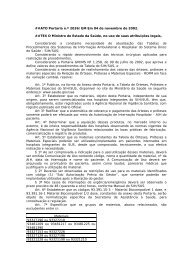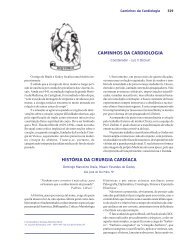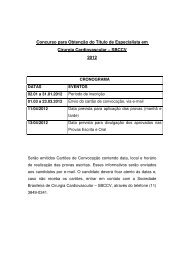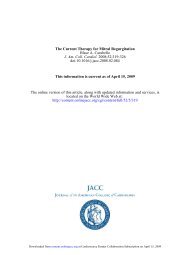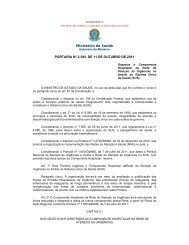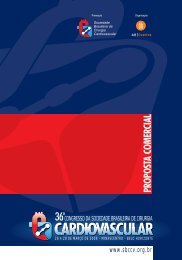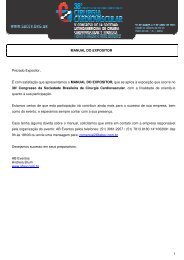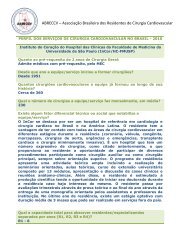“Hybrid” Repair of Aneurysms of the Transverse Aortic Arch: Midterm ...
“Hybrid” Repair of Aneurysms of the Transverse Aortic Arch: Midterm ...
“Hybrid” Repair of Aneurysms of the Transverse Aortic Arch: Midterm ...
Create successful ePaper yourself
Turn your PDF publications into a flip-book with our unique Google optimized e-Paper software.
ADULT CARDIAC<br />
<strong>“Hybrid”</strong> <strong>Repair</strong> <strong>of</strong> <strong>Aneurysms</strong> <strong>of</strong> <strong>the</strong> <strong>Transverse</strong><br />
<strong>Aortic</strong> <strong>Arch</strong>: <strong>Midterm</strong> Results<br />
G. Chad Hughes, MD,* Mani A. Daneshmand, MD, Keki R. Balsara, MD,<br />
Hardean A. Achneck, MD, Bantayehu Sileshi, MD, Sean M. Lee, MD, and<br />
Richard L. McCann, MD<br />
Department <strong>of</strong> Surgery, Duke University Medical Center, Durham, North Carolina<br />
Background. <strong>Aneurysms</strong> <strong>of</strong> <strong>the</strong> transverse aortic arch,<br />
especially those involving <strong>the</strong> mid to distal arch, are<br />
technically challenging to repair with conventional open<br />
techniques. We present our results with a combined<br />
open/endovascular approach (“hybrid repair”) in such<br />
patients.<br />
Methods. From August 11, 2005, to September 18, 2008, 28<br />
patients underwent hybrid arch repair. For patients (n 9)<br />
with distal arch aneurysms but 2 cm or more <strong>of</strong> proximal<br />
landing zone (PLZ) distal to <strong>the</strong> innominate artery, right to<br />
left carotid-carotid bypass was performed to create a PLZ by<br />
covering <strong>the</strong> left carotid origin. For patients (n 12) with<br />
mid arch aneurysms but 2 cm or more <strong>of</strong> PLZ in <strong>the</strong><br />
ascending aorta, proximal ascending aorta-based arch debranching<br />
was performed. For patients (n 7) with arch<br />
aneurysms with no adequate PLZ (“mega aorta”) but adequate<br />
distal landing zone, a stage 1 elephant trunk procedure<br />
was performed to create a PLZ. For <strong>the</strong> first two<br />
groups, endovascular aneurysm exclusion and debranching<br />
were performed concomitantly, whereas <strong>the</strong> procedures<br />
were staged for <strong>the</strong> group undergoing an initial elephant<br />
trunk procedure.<br />
Results. Mean patient age was 64 13 years. Primary<br />
technical success rate was 100%. Thirty-day/in-hospital<br />
rates <strong>of</strong> death, stroke, and permanent paraplegia/paresis<br />
were 0%, 0%, and 3.6% (n 1), respectively. At a mean<br />
follow-up <strong>of</strong> 14 11 months, <strong>the</strong>re have been no late<br />
aortic-related events. Two patients (7%) required secondary<br />
endovascular reintervention for a type 1 endovascular<br />
leak. No patient has a type 1 or 3 endovascular leak at<br />
latest follow-up.<br />
Conclusions. Hybrid repair <strong>of</strong> transverse aortic arch<br />
aneurysms appears safe and effective at midterm follow-up<br />
and may represent a technical advance in <strong>the</strong><br />
treatment <strong>of</strong> this pathology.<br />
(Ann Thorac Surg 2009;88:1882–8)<br />
© 2009 by The Society <strong>of</strong> Thoracic Surgeons<br />
Accepted for publication July 10, 2009.<br />
*Recipient <strong>of</strong> <strong>the</strong> 2008 Clifford Van Meter President’s Award.<br />
Presented at <strong>the</strong> Fifty-fifth Annual Meeting <strong>of</strong> <strong>the</strong> Sou<strong>the</strong>rn Thoracic<br />
Surgical Association, Austin, TX, Nov 5–8, 2008.<br />
Address correspondence to Dr Hughes, Duke University Medical Center,<br />
Box 3051, Division <strong>of</strong> Thoracic and Cardiovascular Surgery, Department<br />
<strong>of</strong> Surgery, Durham, NC 27710; e-mail: gchad.hughes@duke.edu.<br />
<strong>Aneurysms</strong> <strong>of</strong> <strong>the</strong> transverse aortic arch, especially<br />
those involving <strong>the</strong> mid to distal arch, are technically<br />
challenging to repair with conventional open techniques.<br />
This challenge is compounded by arch aneurysms<br />
frequently extending into ei<strong>the</strong>r <strong>the</strong> ascending<br />
aorta or descending aorta, or both (so-called “mega aorta<br />
syndrome” or “extensive aortic aneurysm”), and may<br />
require a two-stage approach for repair. Thoracic endovascular<br />
aneurysm repair (TEVAR) is associated with<br />
lower perioperative morbidity and mortality rates than<br />
conventional open repair, with similar early and midterm<br />
follow-up results [1, 2]. Recent reports [3, 4] have described<br />
<strong>the</strong> use <strong>of</strong> a combined endovascular and open<br />
surgical approach to <strong>the</strong> treatment <strong>of</strong> transverse arch<br />
aneurysms with <strong>the</strong> aim that <strong>the</strong>se “hybrid” techniques<br />
might lower perioperative morbidity and mortality rates,<br />
allow single-stage treatment <strong>of</strong> some pathology previously<br />
requiring two-stage repair, and shorten <strong>the</strong> time<br />
between stages (thus minimizing interval mortality) for<br />
patients still requiring two-stage repair. In <strong>the</strong> current<br />
report, we describe our experience with a combined<br />
open/endovascular approach (“hybrid repair”) in such<br />
patients.<br />
Patients and Methods<br />
Between March 23, 2005 (date <strong>of</strong> Food and Drug Administration<br />
approval <strong>of</strong> <strong>the</strong> first available thoracic device in<br />
<strong>the</strong> United States) and October 23, 2008, 178 thoracic<br />
endograft procedures were performed at our institution.<br />
Of <strong>the</strong>se, 28 (16%) were hybrid arch repairs (performed<br />
between August 11, 2005 and September 18, 2008) and<br />
form <strong>the</strong> basis <strong>of</strong> this report. Indications for surgery<br />
included ei<strong>the</strong>r saccular (n 11) or fusiform (n 17)<br />
aneurysms <strong>of</strong> <strong>the</strong> transverse arch. In 10 patients (36%),<br />
<strong>the</strong> aneurysm was secondary to aortic dissection and<br />
included unrepaired chronic type A dissection in 2,<br />
residual arch/descending dissection after prior type A<br />
dissection repair in 5, acute type B dissection with associated<br />
distal arch/proximal descending aneurysm in 2,<br />
and chronic type B dissection with associated distal<br />
arch/proximal descending aneurysm in 1. Criteria for<br />
© 2009 by The Society <strong>of</strong> Thoracic Surgeons 0003-4975/09/$36.00<br />
Published by Elsevier Inc<br />
doi:10.1016/j.athoracsur.2009.07.027
Ann Thorac Surg<br />
HUGHES ET AL<br />
2009;88:1882–8 HYBRID ARCH REPAIR<br />
1883<br />
repair were as described previously [5]. The presence <strong>of</strong><br />
a connective tissue disorder such as Marfan or Loeys-<br />
Dietz syndrome was considered a contraindication to<br />
hybrid arch repair. The study was approved by <strong>the</strong> Duke<br />
Institutional Review Board, and <strong>the</strong> Board waived <strong>the</strong><br />
need for individual patient consent.<br />
For patients (n 9) with aortic pathology involving <strong>the</strong><br />
distal arch but with 2 cm or more <strong>of</strong> proximal landing<br />
zone (PLZ) distal to <strong>the</strong> innominate artery, right to left<br />
carotid-carotid bypass was utilized to create a PLZ for<br />
stent graft seal. In all cases, <strong>the</strong> procedure was performed<br />
immediately before <strong>the</strong> endograft portion <strong>of</strong> <strong>the</strong> case, as<br />
previously described [6]. The proximal left common carotid<br />
artery (CCA) was ligated below <strong>the</strong> bypass graft<br />
anastomosis (functional end-to-end distal anastomosis)<br />
to prevent type 2 endovascular leak. Three patients (33%)<br />
in this cohort required an iliac conduit to allow safe<br />
ADULT CARDIAC<br />
Fig 2. Intraoperative photograph demonstrating completed concomitant<br />
ascending aortic replacement and arch debranching procedure.<br />
The arch debranching graft (black arrow) has been anastomosed to<br />
<strong>the</strong> proximal end <strong>of</strong> <strong>the</strong> ascending graft, thus creating several centimeters<br />
<strong>of</strong> proximal landing zone (PLZ) in <strong>the</strong> ascending graft above<br />
<strong>the</strong> take<strong>of</strong>f <strong>of</strong> <strong>the</strong> debranching graft. The endograft has been deployed<br />
within <strong>the</strong> ascending graft and <strong>the</strong> proximal antegrade limb<br />
<strong>of</strong> <strong>the</strong> debranching graft (used for introduction <strong>of</strong> <strong>the</strong> endograft and<br />
not visible) has been oversewn.<br />
Fig 1. <strong>Aortic</strong> landing zone map devised by Ishimaru [7] and location<br />
<strong>of</strong> proximal landing zone (PLZ) for hybrid arch patients in <strong>the</strong><br />
present series. Eight <strong>of</strong> 9 patients undergoing adjunctive carotidcarotid<br />
bypass had zone 1 PLZ, with <strong>the</strong> exception being 1 patient<br />
status post ascending aorta to right subclavian artery (SCA) bypass<br />
at <strong>the</strong> time <strong>of</strong> type A dissection repair at ano<strong>the</strong>r institution; she<br />
subsequently underwent right subclavian to right carotid to left carotid<br />
artery bypass to create a zone 0 PLZ. All patients undergoing<br />
ascending aortic-based arch debranching procedures (n 12) had<br />
zone 0 PLZ, in addition to <strong>the</strong> single carotid-carotid bypass patient<br />
(n 13 total zone 0 PLZ). Patients (n 7) undergoing first-stage<br />
total arch replacement/elephant trunk had zone 3/4 PLZ in <strong>the</strong> elephant<br />
trunk graft. (Modified from Ishimaru S, J Endovasc Ther<br />
2004;11:II62–71 [7], with permission from Allen Press Publishing<br />
Services.)<br />
introduction <strong>of</strong> <strong>the</strong> introducer sheath necessary for <strong>the</strong><br />
procedure. The left subclavian artery (SCA) was fully<br />
covered in all <strong>of</strong> <strong>the</strong>se patients, and 3 (33%) underwent<br />
adjunctive left carotid-subclavian bypass during <strong>the</strong><br />
same operation as endovascular repair. Indications for<br />
left carotid-subclavian bypass were as previously described<br />
[5]. One patient in this group had undergone<br />
prior ascending aortic replacement for repair <strong>of</strong> a type A<br />
aortic dissection at ano<strong>the</strong>r institution and had concomitant<br />
ascending aorta to right SCA bypass performed as<br />
part <strong>of</strong> that procedure. This bypass served as inflow for<br />
subsequent right subclavian to right carotid to left carotid<br />
bypass, thus allowing a zone 0 PLZ, using <strong>the</strong> aortic<br />
landing zone map devised by Ishimaru [7]. The o<strong>the</strong>r<br />
patients in this group had zone 1 PLZ (Fig 1).<br />
For patients (n 12) with aneurysms involving <strong>the</strong> mid<br />
transverse arch but with 2 cm or more <strong>of</strong> PLZ in <strong>the</strong><br />
ascending aorta, ascending aortic-based arch debranching<br />
was performed as previously described [4–6] using a<br />
custom designed “hybrid antegrade arch graft” (Vascutek<br />
USA, Ann Arbor, MI) to debranch <strong>the</strong> innominate<br />
and left CCA; <strong>the</strong> graft incorporates an antegrade limb<br />
that allows endograft introduction across <strong>the</strong> arch without<br />
need for femoral exposure. The left SCA was fully
1884 HUGHES ET AL Ann Thorac Surg<br />
HYBRID ARCH REPAIR 2009;88:1882–8<br />
ADULT CARDIAC<br />
covered in all <strong>of</strong> <strong>the</strong>se patients, and 2 (17%) underwent<br />
adjunctive left carotid-subclavian bypass during <strong>the</strong><br />
same operation. In 3 <strong>of</strong> <strong>the</strong>se patients (25%), <strong>the</strong> ascending<br />
aortic-based arch debranching procedure involved<br />
redo sternotomy status post prior type A dissection<br />
repair. The existing Dacron graft served as PLZ as well as<br />
<strong>the</strong> proximal anastomotic site for <strong>the</strong> arch debranching<br />
graft in <strong>the</strong>se cases. One additional patient underwent<br />
supracoronary ascending aortic replacement at <strong>the</strong> time<br />
<strong>of</strong> arch debranching to create PLZ, given his ascending<br />
aortic diameter <strong>of</strong> 4.6 cm, which was too large for stent<br />
graft proximal seal; <strong>the</strong> arch debranching graft was<br />
subsequently anastomosed to <strong>the</strong> new ascending Dacron<br />
Fig 3. Drawing demonstrating modified Mt. Sinai technique [8] used<br />
for first-stage total arch replacement in patients with extensive thoracic<br />
aortic disease but adequate distal landing zone (DLZ) in descending<br />
aorta. (A) The right axillary artery is cannulated with an 8<br />
mm Dacron graft using a side graft technique. (B) After cooling to<br />
electrocerebral inactivity by electroencephalogram, <strong>the</strong> three arch<br />
vessels are divided from <strong>the</strong>ir origins at <strong>the</strong> arch, clamped, and antegrade<br />
cerebral perfusion from <strong>the</strong> right axillary graft begun. (C) A<br />
trifurcated graft is <strong>the</strong>n anastomosed to <strong>the</strong> arch vessels, and full<br />
flow to <strong>the</strong> upper body resumed at 12°C. The collared elephant trunk<br />
graft is <strong>the</strong>n anastomosed to <strong>the</strong> divided arch, after which lower<br />
body perfusion is resumed and rewarming begun through aYin<strong>the</strong><br />
arterial line and <strong>the</strong> integral side arm in <strong>the</strong> elephant trunk graft.<br />
The collar allows <strong>the</strong> elephant trunk anastomosis to be better<br />
matched to <strong>the</strong> diameter <strong>of</strong> <strong>the</strong> dilated transverse arch, which decreases<br />
tension at this anastomosis [9]. (D) Completed first-stage<br />
repair.<br />
graft (Fig 2). Thus, a total <strong>of</strong> 4 patients (33%) in this group<br />
had PLZ in Dacron grafts. The TEVAR portion <strong>of</strong> <strong>the</strong><br />
procedure (zone 0 PLZ; Fig 1) was performed immediately<br />
after arch debranching and before closure <strong>of</strong> <strong>the</strong><br />
sternotomy in all <strong>of</strong> <strong>the</strong>se cases.<br />
All arch debranching patients underwent preoperative<br />
transthoracic echocardiography and coronary angiography<br />
to rule out significant valvular or coronary artery<br />
disease, which was addressed surgically at <strong>the</strong> time <strong>of</strong> <strong>the</strong><br />
hybrid arch procedure. Adjunctive cardiac surgical procedures<br />
were performed in 4 patients (33%): coronary<br />
artery bypass grafting (CABG) in 2, aortic valve replacement<br />
in 1, and as described above, supracoronary ascending<br />
aortic replacement for ascending aneurysm in 1.<br />
The arch debranching procedure was performed on cardiopulmonary<br />
bypass in <strong>the</strong>se 4 patients, as well as in an<br />
additional patient (total n 5 [42%] on pump) after prior<br />
ascending aortic Dacron graft replacement for type A<br />
dissection repair 9 years earlier. Cardiopulmonary bypass<br />
was necessary in this patient to repair an intraoperative<br />
main pulmonary artery injury.<br />
For patients (n 7) with aneurysms involving <strong>the</strong><br />
transverse arch with no adequate PLZ (mega aorta) but<br />
adequate distal landing zone (DLZ), a first-stage total<br />
arch replacement (stage 1 elephant trunk procedure) was<br />
performed to treat <strong>the</strong> proximal aortic pathology and<br />
create PLZ. This was performed using a modified Mt.<br />
Sinai technique (Fig 3) [8, 9]. In 3 patients (43%), <strong>the</strong><br />
procedure involved redo sternotomy after prior type A<br />
dissection repair (n 2) or mechanical root replacement<br />
(n 1); <strong>the</strong> existing ascending/root graft was deemed<br />
unsuitable for PLZ in <strong>the</strong>se patients, thus necessitating<br />
total arch replacement. Concomitant cardiac surgical<br />
procedures were performed in 4 patients (57%), including<br />
CABG (n 3) and CABG plus aortic valve replacement<br />
(n 1). Unlike <strong>the</strong> previously described hybrid<br />
approaches, <strong>the</strong> arch replacement procedure and TEVAR<br />
were staged.<br />
Surgical considerations specific to <strong>the</strong> first stage include<br />
choosing <strong>the</strong> diameter <strong>of</strong> <strong>the</strong> elephant trunk graft<br />
so that it matches that <strong>of</strong> <strong>the</strong> proposed DLZ in native<br />
aorta. Specifically, a graft diameter 2 to 4 mm smaller<br />
than that <strong>of</strong> <strong>the</strong> distal aorta was utilized to allow for <strong>the</strong><br />
natural dilation that occurs in Dacron grafts after implantation.<br />
Matching <strong>the</strong> diameter <strong>of</strong> <strong>the</strong> elephant trunk graft<br />
and DLZ allows a single endograft to complete <strong>the</strong> repair<br />
in many cases. Fur<strong>the</strong>r, using a smaller diameter elephant<br />
trunk allows <strong>the</strong> endografts to be deployed from<br />
proximal to distal if multiple devices are required, which<br />
simplifies <strong>the</strong> second-stage endovascular repair. Four<br />
large hemoclips are placed on <strong>the</strong> distal end <strong>of</strong> <strong>the</strong> graft<br />
to assist with identification under fluoroscopy. Two pacing<br />
wires (# 0) are likewise attached to <strong>the</strong> distal end <strong>of</strong><br />
<strong>the</strong> elephant trunk to allow <strong>the</strong> graft to be snared at <strong>the</strong><br />
second-stage operation to provide countertraction as <strong>the</strong><br />
endovascular graft is advanced into <strong>the</strong> elephant trunk.<br />
This helps avoid <strong>the</strong> tendency <strong>of</strong> <strong>the</strong> Dacron graft to<br />
invert on itself. Several additional endovascular techniques<br />
[6] facilitate completion <strong>of</strong> <strong>the</strong> second-stage procedure<br />
and include gaining initial access to <strong>the</strong> elephant
Ann Thorac Surg<br />
HUGHES ET AL<br />
2009;88:1882–8 HYBRID ARCH REPAIR<br />
1885<br />
trunk from a right brachial approach ra<strong>the</strong>r than trying to<br />
access <strong>the</strong> graft from below, which can be difficult in <strong>the</strong><br />
presence <strong>of</strong> a large descending aneurysm. The wire<br />
placed from <strong>the</strong> right brachial access may <strong>the</strong>n be snared<br />
(body floss technique) to guide a wire from below into<br />
<strong>the</strong> Dacron graft. The use <strong>of</strong> a 65-cm introducer sheath<br />
(Keller-Timmerman, Cook Medical, Bloomington, IN),<br />
which can be advanced well into <strong>the</strong> Dacron sleeve, also<br />
facilitates endograft passage into <strong>the</strong> elephant trunk<br />
when utilizing <strong>the</strong> Gore TAG device (W.L Gore & Assoc,<br />
Flagstaff, AZ), as this particular endograft has a tendency<br />
to hang up on <strong>the</strong> Dacron fabric.<br />
Devices utilized for hybrid arch repairs were <strong>the</strong> Gore<br />
TAG device in 27 patients and <strong>the</strong> Zenith TX2 device<br />
(Cook Medical, Bloomington, IN) in 1 patient. Details<br />
regarding devices and technique <strong>of</strong> delivery and deployment<br />
have been previously described [10, 11]. Preoperative<br />
planning and intraoperative conduct <strong>of</strong> TEVAR were<br />
as described previously [4–6].<br />
On-line monitoring <strong>of</strong> spinal cord function with somatosensory<br />
and motor evoked potentials was used<br />
intraoperatively in elective cases and when available for<br />
urgent cases (n 24 cases monitored; 86%), using previously<br />
described techniques [12]. Cerebrospinal fluid<br />
drainage was used selectively (n 2; 7%) for previously<br />
described indications [5].<br />
Comorbidities were defined using standard definitions.<br />
All procedural outcomes and complications were<br />
prospectively recorded. Patient follow-up protocol was as<br />
previously described [5]. All follow-up was done at <strong>the</strong><br />
Duke University Center for <strong>Aortic</strong> Surgery. This report<br />
includes all data collected through <strong>the</strong> patients’ most<br />
recent follow-up visit. In addition, <strong>the</strong> Social Security Death<br />
Index was queried (available at: http://ssdi.rootsweb.com/)<br />
to confirm all patient deaths. For those patients dying<br />
during follow-up, cause <strong>of</strong> death was confirmed by review<br />
<strong>of</strong> medical records or family interview in all cases.<br />
Survival analyses were performed using <strong>the</strong> Kaplan-<br />
Meier method. All data are presented in accordance with<br />
<strong>the</strong> “Reporting Standards for Endovascular <strong>Aortic</strong> Aneurysm<br />
<strong>Repair</strong>” <strong>of</strong> <strong>the</strong> Ad Hoc Committee for Standardized<br />
Reporting Practices in Vascular Surgery <strong>of</strong> <strong>the</strong> Society for<br />
Vascular Surgery/American Association for Vascular<br />
Surgery [13].<br />
Table 1. Patient Demographics<br />
Mean age, years 64 13 (range, 31 to 84)<br />
Female n 13 (46%)<br />
Hypertension n 25 (89%)<br />
Diabetes mellitus n 6 (21%)<br />
Coronary artery disease n 11 (39%)<br />
Chronic obstructive pulmonary<br />
n 5 (18%)<br />
disease<br />
Chronic renal insufficiency (baseline n 8 (29%)<br />
creatinine 1.5 mg/dL)<br />
Peripheral vascular disease n 7 (25%)<br />
Prior open aortic surgery n 11 (39%)<br />
Results<br />
Patient Demographics<br />
Mean aneurysm diameter was 6.1 1.6 cm (range, 3.1 to<br />
11.0 cm). Patient demographics are presented in Table 1.<br />
Eleven (39%) had undergone prior open aortic surgery,<br />
including prior ascending aortic replacement for type A<br />
dissection in 6 (21%). The distal extent <strong>of</strong> aortic coverage<br />
by <strong>the</strong> endografts was above T6 in 18 (64%) and below T6<br />
in 10 (36%). Thirteen (46%) <strong>of</strong> <strong>the</strong> patients were symptomatic<br />
with pain symptoms; 21% (6 <strong>of</strong> 28) <strong>of</strong> <strong>the</strong> cases<br />
were urgent (aneurysm repaired during <strong>the</strong> same hospital<br />
admission as discovered). None <strong>of</strong> <strong>the</strong> cases was<br />
emergent, and all patients were hemodynamically stable<br />
without frank rupture at <strong>the</strong> time <strong>of</strong> surgery.<br />
Procedural (30-Day) Outcomes<br />
All patients (n 7) undergoing first-stage elephant trunk<br />
underwent second-stage repair, with <strong>the</strong> interval between<br />
stages ranging from 8 days to 7 months (median,<br />
10 weeks); 2 patients (29%) underwent second-stage<br />
repair during <strong>the</strong> index hospitalization. Primary technical<br />
success, defined as successful endovascular graft deployment<br />
with no type 1 or 3 endovascular leak and absence<br />
<strong>of</strong> open surgical conversion or mortality within <strong>the</strong> first<br />
24 hours postoperatively [13], was achieved in all cases.<br />
The mean number <strong>of</strong> stent grafts per case was 1.7 0.7<br />
(range, 1 to 3); median device diameter was 34 mm.<br />
Thirty-day/in-hospital rates <strong>of</strong> death, stroke, and permanent<br />
paraplegia/paresis were 0%, 0%, and 3.6% (n <br />
1), respectively. These data include first-stage elephant<br />
trunk procedures, combined debranching and endovascular<br />
repairs, as well as second-stage TEVAR in patients<br />
undergoing first-stage elephant trunk. Details <strong>of</strong> <strong>the</strong><br />
single patient with paraplegia have been previously<br />
described [5].<br />
O<strong>the</strong>r major perioperative morbidity was seen in 6<br />
patients (21%) and included respiratory failure requiring<br />
reintubation (n 2), left neck hematoma requiring reexploration<br />
after carotid-subclavian bypass (n 1), mediastinal<br />
bleeding requiring reexploration (n 1), left<br />
upper extremity ischemia secondary to left SCA coverage<br />
by <strong>the</strong> endograft requiring left carotid-subclavian bypass<br />
on postoperative day 2 (n 1), and intraoperative left<br />
common iliac rupture requiring covered stent repair and<br />
subsequent femoral-femoral bypass after stent thrombosis<br />
on postoperative day 1 (n 1). The median hospital<br />
length <strong>of</strong> stay was 6 days for endovascular repairs.<br />
Follow-Up Outcomes<br />
Follow-up is 100% complete. The incidence <strong>of</strong> type 1 or 3<br />
endovascular leak at any follow-up visit was 7% (n 2);<br />
both were proximal type 1 endovascular leaks in arch<br />
debranching patients where <strong>the</strong> endograft PLZ was in an<br />
ascending aortic Dacron graft. Both were treated successfully<br />
with proximal endograft cuff extension. Three patients<br />
(11%) had type 2 endovascular leaks noted on<br />
follow-up imaging. Of <strong>the</strong>se, 2 were due to retrograde<br />
flow from <strong>the</strong> left SCA and were successfully treated with<br />
late coil embolization. The o<strong>the</strong>r is a small type 2 endo-<br />
ADULT CARDIAC
1886 HUGHES ET AL Ann Thorac Surg<br />
HYBRID ARCH REPAIR 2009;88:1882–8<br />
ADULT CARDIAC<br />
vascular leak secondary to an intercostal artery and is<br />
being followed. No patient has a type 1 or 3 endovascular<br />
leak at latest follow-up.<br />
Clinical success, defined as absence <strong>of</strong> death as a result<br />
<strong>of</strong> aneurysm-related treatment, persistent type 1 or 3<br />
endovascular leak, graft infection or thrombosis, aneurysm<br />
expansion or rupture, or conversion to open repair<br />
[13] was 100% at a mean duration <strong>of</strong> follow-up <strong>of</strong> 14 11<br />
months (range, 1 to 36). Overall actuarial midterm survival<br />
is 70% at 36 months, with an aorta-specific actuarial<br />
survival <strong>of</strong> 100% during this same interval.<br />
Comment<br />
<strong>Aneurysms</strong> <strong>of</strong> <strong>the</strong> transverse aortic arch, especially those<br />
involving <strong>the</strong> mid to distal arch, are technically challenging<br />
to repair with conventional open techniques. These<br />
challenges relate to difficulties with exposure, need for<br />
deep hypo<strong>the</strong>rmic circulatory arrest, and frequent requirement<br />
for a two-stage approach to complete repair.<br />
Total arch replacement, although now performed routinely<br />
and safely in centers with expertise, still carries a<br />
perioperative death or stroke rate approaching 15%, even<br />
in expert hands [8, 14]. Fur<strong>the</strong>r, a significant number <strong>of</strong><br />
patients may become unfit or refuse <strong>the</strong> second stage,<br />
and perioperative second stage mortality rates approach<br />
10% for patients fit enough to undergo an additional<br />
open procedure for downstream repair [15]. This is in<br />
contrast to <strong>the</strong> results <strong>of</strong> <strong>the</strong> present report, in which no<br />
deaths or strokes were seen in 28 consecutive patients<br />
undergoing hybrid arch repair. Similar low rates <strong>of</strong><br />
perioperative morbidity and mortality with hybrid arch<br />
repair have been reported by o<strong>the</strong>rs [3, 16].<br />
Potential advantages <strong>of</strong> <strong>the</strong> hybrid approach over conventional<br />
repair for arch pathology are several. First,<br />
<strong>the</strong>se procedures, which avoid <strong>the</strong> need for cardiopulmonary<br />
bypass and aortic cross-clamping in most patients,<br />
may have advantages for high-risk patients, including<br />
<strong>the</strong> potential to <strong>of</strong>fer <strong>the</strong>rapy to patients who are not<br />
candidates for conventional open repair [4]. Second, endovascular<br />
grafts can be deployed from <strong>the</strong> ascending aorta<br />
down to <strong>the</strong> level <strong>of</strong> <strong>the</strong> celiac axis, thus allowing pathology<br />
<strong>of</strong> <strong>the</strong> arch and descending aorta previously requiring<br />
ei<strong>the</strong>r extensive single stage repair through bilateral thoracosternotomy<br />
[17] or two-stage repair [15, 18–20] to be<br />
treated in a single-stage procedure. Finally, for patients<br />
still requiring a two-stage approach, <strong>the</strong> second-stage<br />
endovascular repair may be performed much sooner<br />
than a second open procedure (even during <strong>the</strong> same<br />
hospitalization as arch replacement, as was done in<br />
nearly a third <strong>of</strong> patients in <strong>the</strong> current series), given <strong>the</strong><br />
minimal physiologic insult <strong>of</strong> TEVAR and <strong>the</strong> fact that it<br />
is well tolerated even by patients who have recently<br />
undergone major open surgery. This represents a significant<br />
advance over conventional open second-stage repair<br />
and may eliminate <strong>the</strong> known risk <strong>of</strong> death from<br />
distal aortic complications between stages [15, 18–20].<br />
Fur<strong>the</strong>r, large series <strong>of</strong> patients undergoing first-stage<br />
elephant trunk demonstrate that only approximately 50%<br />
return for open second-stage repair [15, 18–20], a number<br />
that should be greatly improved when <strong>the</strong> second procedure<br />
is performed using endovascular means. This is<br />
evidenced by all patients in <strong>the</strong> current series who<br />
underwent first-stage elephant trunk also underwent<br />
subsequent second-stage repair.<br />
The so-called frozen elephant trunk technique [21–23]<br />
has also been suggested as a means to treat extensive<br />
thoracic aortic aneurysm in a single-stage procedure.<br />
This technique involves placement <strong>of</strong> an endovascular<br />
stent graft antegrade through <strong>the</strong> open arch at <strong>the</strong> same<br />
operation as <strong>the</strong> elephant trunk procedure. Although this<br />
approach has <strong>the</strong> advantage <strong>of</strong> eliminating <strong>the</strong> potential<br />
for interval aortic-related death between stages, it adds<br />
additional physiologic insult to an already significant<br />
operation. That is especially true with regard to renal<br />
function if contrast angiography is utilized for <strong>the</strong> endovascular<br />
graft portion <strong>of</strong> <strong>the</strong> case. As such, we believe<br />
<strong>the</strong>se procedures are best staged, even if only for a few<br />
days, to allow <strong>the</strong> patient some recovery period after total<br />
arch replacement. The results <strong>of</strong> <strong>the</strong> present series would<br />
appear to support this contention, given <strong>the</strong> lack <strong>of</strong><br />
interval mortality between staged repairs. Fur<strong>the</strong>r, rates<br />
<strong>of</strong> spinal cord ischemia appear increased with <strong>the</strong> frozen<br />
elephant trunk approach, averaging 10% in most series [21,<br />
23]. One potential explanation for this observation is that<br />
<strong>the</strong> ability to maintain supranormal mean arterial pressures<br />
to augment spinal cord blood flow may be limited by<br />
bleeding complications in this scenario, and that <strong>the</strong> use <strong>of</strong><br />
cerebrospinal fluid drainage may be contraindicated owing<br />
to concerns over coagulopathy and central nervous system<br />
bleeding complications. There were no episodes <strong>of</strong> spinal<br />
cord ischemia after second-stage endovascular grafting in<br />
patients undergoing initial elephant trunk in <strong>the</strong> present<br />
series, which may support this hypo<strong>the</strong>sis.<br />
One potential word <strong>of</strong> caution with regard to <strong>the</strong> use <strong>of</strong><br />
ascending aorta-based arch debranching procedures relates<br />
to <strong>the</strong> use <strong>of</strong> existing Dacron grafts for PLZ. Both<br />
type 1 endovascular leaks observed in this series were<br />
proximal type 1 leaks around endovascular grafts with<br />
proximal seal zone in an ascending Dacron graft. That<br />
equates to a 50% type 1 endovascular leak incidence in<br />
this group, as only 4 patients had PLZ in an ascending<br />
Dacron graft. We speculate that <strong>the</strong> presence <strong>of</strong> an<br />
endograft in a Dacron graft may promote additional<br />
dilation <strong>of</strong> <strong>the</strong> Dacron above that normally occurring,<br />
thus leading to late endovascular leak formation. Alternatively,<br />
<strong>the</strong> less compliant nature <strong>of</strong> Dacron as compared<br />
with native aorta may result in suboptimal endograft apposition.<br />
Although both proximal endovascular leaks in <strong>the</strong><br />
current series were successfully treated with proximal cuff<br />
extensions, this is technically challenging because <strong>of</strong> <strong>the</strong><br />
100-cm length <strong>of</strong> <strong>the</strong> devices and difficulty reaching <strong>the</strong><br />
ascending aorta from <strong>the</strong> groin at a second procedure. In<br />
1 <strong>of</strong> <strong>the</strong> 2 patients, <strong>the</strong> endograft had to be deployed<br />
“bareback” without a sheath to allow it to reach far<br />
enough proximally into <strong>the</strong> ascending graft to achieve<br />
proximal seal. Based on <strong>the</strong>se results, we suggest oversizing<br />
<strong>the</strong> endograft 20%, as well as a PLZ <strong>of</strong> at least 4 cm,<br />
when landing in Dacron to prevent this complication.
Ann Thorac Surg<br />
HUGHES ET AL<br />
2009;88:1882–8 HYBRID ARCH REPAIR<br />
1887<br />
Finally, although we continue to perform total arch<br />
replacement regularly for <strong>the</strong> treatment <strong>of</strong> extensive<br />
thoracic aortic disease, going forward, one must consider<br />
whe<strong>the</strong>r this operation will remain widely utilized by <strong>the</strong><br />
thoracic aortic surgeon, especially in older patients with<br />
significant comorbidity. Although not utilized in <strong>the</strong><br />
present series, one could hypo<strong>the</strong>size an operation<br />
whereby proximal aortic arch replacement (namely,<br />
hemiarch) is performed with concomitant performance<br />
<strong>of</strong> partial or complete arch debranching without creating<br />
an elephant trunk. The advantage <strong>of</strong> such an operation<br />
would be <strong>the</strong> shorter period <strong>of</strong> circulatory arrest needed<br />
for performance <strong>of</strong> hemiarch versus full arch, as <strong>the</strong><br />
debranching procedure could be performed during rewarming<br />
without <strong>the</strong> need for deep hypo<strong>the</strong>rmic circulatory<br />
arrest. The diseased arch could <strong>the</strong>n be excluded<br />
through endovascular means, ei<strong>the</strong>r at <strong>the</strong> same operation<br />
or in a staged manner, with endografts extending<br />
from <strong>the</strong> hemiarch graft down into DLZ in <strong>the</strong> descending<br />
thoracic aorta. We would speculate that a combined<br />
hemiarch/arch debranching procedure would pose a<br />
lesser physiologic insult than total arch replacement and<br />
would likely be better tolerated by patients with limited<br />
physiologic reserve. This should serve as an area <strong>of</strong><br />
additional investigation in <strong>the</strong> future.<br />
In summary, <strong>the</strong> use <strong>of</strong> a hybrid endovascular and<br />
open surgical approach to <strong>the</strong> treatment <strong>of</strong> transverse<br />
arch aneurysms appears safe and effective at early midterm<br />
follow-up and <strong>of</strong>fers several advantages over conventional<br />
repair, including <strong>the</strong> potential to <strong>of</strong>fer <strong>the</strong>rapy<br />
to patients who are not candidates for open repair,<br />
single-stage treatment <strong>of</strong> some pathology previously requiring<br />
two-stage repair, and a shorter time between stages<br />
(thus minimizing interval mortality) for patients still requiring<br />
two-stage repair. As such, this approach may represent<br />
a technical advance in <strong>the</strong> treatment <strong>of</strong> this pathology.<br />
References<br />
1. Bavaria JE, Appoo JJ, Makaroun MS, Verter J, Yu Z-F,<br />
Mitchell RS, for <strong>the</strong> Gore TAG Investigators. Endovascular<br />
stent grafting versus open surgical repair <strong>of</strong> descending<br />
thoracic aortic aneurysms in low-risk patients: a multicenter<br />
comparative trial. J Thorac Cardiovasc Surg 2007;133:369–77.<br />
2. Stone DH, Brewster DC, Kwolek CJ, et al. Stent-graft versus<br />
open-surgical repair <strong>of</strong> <strong>the</strong> thoracic aorta: mid-term results.<br />
J Vasc Surg 2006;44:1188–97.<br />
3. Gottardi R, Funovics M, Eggers N, et al. Supra-aortic transposition<br />
for combined vascular and endovascular repair <strong>of</strong><br />
aortic arch pathology. Ann Thorac Surg 2008;86:1524–9.<br />
4. Hughes GC, Nienaber JJ, Bush EL, et al. Use <strong>of</strong> custom<br />
dacron branch grafts for “hybrid” aortic debranching during<br />
endovascular repair <strong>of</strong> thoracic and thoracoabdominal aortic<br />
aneurysms. J Thorac Cardiovasc Surg 2008;136:21–8.<br />
5. Hughes GC, Daneshmand MA, Swaminathan M, et al. “Real<br />
world” thoracic endografting: results with <strong>the</strong> Gore TAG<br />
device 2 Years following U.S. FDA approval. Ann Thorac<br />
Surg 2008;86:1530–8.<br />
6. Hughes GC, McCann RL, Sulzer CF, Swaminathan M. Endovascular<br />
approaches to complex thoracic aortic disease.<br />
Semin Cardiothorac Vasc Anesth 2008;12:298–319.<br />
7. Ishimaru S. Endografting <strong>of</strong> <strong>the</strong> aortic arch. J Endovasc Ther<br />
2004;11:II62–71.<br />
8. Strauch JT, Spielvogel D, Lauten A, et al. Technical advances<br />
in total aortic arch replacement. Ann Thorac Surg 2004;77:<br />
581–90.<br />
9. Neri E, Massetti M, Sani G. The “elephant trunk” technique<br />
made easier. Ann Thorac Surg 2004;78:e17–8.<br />
10. Wheatley GH, Gurbuz AT, Rodriguez-Lopez JA, et al. <strong>Midterm</strong><br />
outcome in 158 consecutive Gore TAG thoracic endopros<strong>the</strong>ses:<br />
single center experience. Ann Thorac Surg 2006;<br />
81:1570–7.<br />
11. Greenberg RK, O’Neill S, Walker E, et al. Endovascular<br />
repair <strong>of</strong> thoracic aortic lesions with <strong>the</strong> Zenith TX1 and TX2<br />
thoracic grafts: intermediate-term results. J Vasc Surg 2005;<br />
41:589–96.<br />
12. Husain AH, Swaminathan M, McCann RL, Hughes GC.<br />
Neurophysiologic intraoperative monitoring during endovascular<br />
stent graft repair <strong>of</strong> <strong>the</strong> descending thoracic aorta.<br />
J Clin Neurophysiol 2007;4:328–35.<br />
13. Chaik<strong>of</strong> EL, Blankensteijn JD, Harris PL, et al. Reporting<br />
standards for endovascular aortic aneurysm repair. J Vasc<br />
Surg 2002;35:1048–60.<br />
14. Sundt TM, Orszulak TA, Cook DJ, Schaff HV. Improving<br />
results <strong>of</strong> open arch replacement. Ann Thorac Surg 2008;86:<br />
787–96.<br />
15. Safi HJ, Miller CC, Estrera AL, et al. Optimization <strong>of</strong> aortic<br />
arch replacement: two-stage approach. Ann Thorac Surg<br />
2007;83(Suppl):815–8.<br />
16. Wang S, Chang G, Li X, et al. Endovascular treatment <strong>of</strong> arch<br />
and proximal thoracic aortic lesions. J Vasc Surg 2008;48:<br />
64–8.<br />
17. Kouchoukos NT, Mauney MC, Masetti P, Castner CF. Single-stage<br />
repair <strong>of</strong> extensive thoracic aortic aneurysms: experience<br />
with <strong>the</strong> arch-first technique and bilateral anterior<br />
thoracotomy. J Thorac Cardiovasc Surg 2004;128:669–76.<br />
18. Safi HJ, Miller CC, Estrera AL, et al. Staged repair <strong>of</strong><br />
extensive aortic aneurysms: morbidity and mortality in <strong>the</strong><br />
elephant trunk technique. Circulation 2001;104:2938–42.<br />
19. Svensson LG, Kim K-H, Blackstone EH, et al. Elephant trunk<br />
procedure: newer indications and uses. Ann Thorac Surg<br />
2004;78:109–16.<br />
20. Schepens MA, Dossche KM, Morshuis WJ, et al. The elephant<br />
trunk technique: operative results in 100 consecutive<br />
patients. Eur J Cardiothorac Surg 2002;21:276–81.<br />
21. Karck M, Chavan A, Khaladj N, et al. The frozen elephant<br />
trunk technique for <strong>the</strong> treatment <strong>of</strong> extensive thoracic aortic<br />
aneurysms: operative results and follow-up. Eur J Cardiothorac<br />
Surg 2005;28:286–90.<br />
22. Baraki H, Hagl C, Khaladj N, et al. The frozen elephant trunk<br />
technique for treatment <strong>of</strong> thoracic aortic aneurysms. Ann<br />
Thorac Surg 2007;83(Suppl):819–23.<br />
23. Karck M, Kamiya H. Progress <strong>of</strong> <strong>the</strong> treatment for extended<br />
aortic aneurysms: is <strong>the</strong> frozen elephant trunk technique <strong>the</strong><br />
next standard in <strong>the</strong> treatment <strong>of</strong> complex aortic disease<br />
including <strong>the</strong> arch Eur J Cardiothorac Surg 2008;33:1007–13.<br />
ADULT CARDIAC<br />
DISCUSSION<br />
DR JOSEPH S. COSELLI (Houston, TX): Congratulations on an<br />
excellent presentation and on your terrific results on really<br />
clinically challenging cases using innovative approaches. You<br />
describe 28 patients with aortic aneurysms <strong>of</strong> <strong>the</strong> arch treated<br />
operatively with a combination <strong>of</strong> traditional open techniques as<br />
well as TEVAR technologies in <strong>the</strong> so-called hybrid procedures.<br />
Your primary technical success was 100%, operative death and<br />
stroke, 0%, and permanent spinal cord deficits, 3.6%. Your<br />
manuscript includes some very important technical details, such<br />
as information regarding choosing <strong>the</strong> elephant trunk diameter
1888 HUGHES ET AL Ann Thorac Surg<br />
HYBRID ARCH REPAIR 2009;88:1882–8<br />
ADULT CARDIAC<br />
to optimize <strong>the</strong> landing zone. You recommend, for instance,<br />
choosing an arch graft that has a diameter 2 to 4 mm smaller<br />
than that <strong>of</strong> <strong>the</strong> distal aortic landing zone. You also emphasize<br />
<strong>the</strong> importance <strong>of</strong> oversizing <strong>the</strong> endograft by 20%, as opposed<br />
to <strong>the</strong> usual 10%, and allowing for at least 4 cm instead <strong>of</strong> 2 cm<br />
for overlap when landing in <strong>the</strong> Dacron; this is particularly<br />
important because <strong>of</strong> <strong>the</strong> Dacron’s tendency to dilate over time,<br />
which caused two late type 1 endovascular leaks in your series.<br />
Additionally, you mention placing clips and wires on <strong>the</strong> end<br />
<strong>of</strong> <strong>the</strong> elephant trunk along with some techniques for accessing<br />
<strong>the</strong> elephant trunk from <strong>the</strong> femoral artery, which can be a<br />
challenging problem. A technique that we have used in addition<br />
to <strong>the</strong>se is placing a totally occluding balloon in <strong>the</strong> distal end <strong>of</strong><br />
<strong>the</strong> elephant trunk and allowing several heart beats to expand<br />
<strong>the</strong> elephant trunk and bring it down to its full length, <strong>the</strong>reby<br />
opening it up widely for easier access. Clearly, industry has got<br />
some technological issues with <strong>the</strong> way <strong>the</strong> stent grafts, particularly<br />
<strong>the</strong> one that you used in your series, drag on <strong>the</strong> elephant<br />
trunk graft and create an accordion effect; this has created a<br />
challenging situation for all <strong>of</strong> us, and you have described some<br />
techniques in your report which I think are valuable.<br />
The questions I have for you are really quite simple. One is, were<br />
all <strong>of</strong> your carotid-carotid bypasses anterior I am also curious<br />
about your use <strong>of</strong> somatosensory and motor evoked potential<br />
monitoring in this setting. You used it in 86% <strong>of</strong> cases. I particularly<br />
raise this issue because you do not routinely use cerebrospinal<br />
fluid (CSF) drainage. You used it in only 7% <strong>of</strong> your cases. My<br />
question ishow do you use <strong>the</strong> motor evoked potential or somatosensory<br />
evoked potential monitoring information Was it truly<br />
useful in this setting For instance, if you lose signals after your<br />
graft deployment and you don’t have a CSF ca<strong>the</strong>ter in, what do<br />
you do Certainly, you can increase <strong>the</strong> blood pressure to supernormal<br />
levels and perhaps even insert a CSF ca<strong>the</strong>ter later, but that<br />
is delayed and it may not be in enough time. So do you have any<br />
o<strong>the</strong>r strategies to respond to signal loss Once again, congratulations<br />
on terrific results in challenging cases. Thank you.<br />
DR HUGHES: Thanks, Dr Coselli, for your comments. We also<br />
have used <strong>the</strong> technique that you discuss with <strong>the</strong> balloon. We<br />
have generally used it if we have a problem when advancing <strong>the</strong><br />
endograft into <strong>the</strong> elephant trunk, such that <strong>the</strong> Dacron graft<br />
“accordions” on itself. In this scenario, if you put, for instance, a<br />
Coda balloon up inside <strong>the</strong> Dacron graft, inflate it, and pull<br />
down, you can recover from this situation, which can be problematic.<br />
Most <strong>of</strong> <strong>the</strong>se patients were done before TX2 or Talent<br />
were FDA approved, and I think <strong>the</strong> TX2 device is probably<br />
going to be a better fit for landing in an elephant trunk than<br />
TAG, because it doesn’t have <strong>the</strong> flares that tend to catch on <strong>the</strong><br />
Dacron. So we will see about that.<br />
With regard to your question about carotid-carotid bypass, we<br />
have done all <strong>of</strong> <strong>the</strong>m anteriorly, as is our preference. Some people,<br />
as you know, tunnel <strong>the</strong> graft retropharyngeally. The one potential<br />
issue with anterior placement is if someone were to subsequently<br />
need a tracheostomy; we have had 1 case where we purposely<br />
tunneled <strong>the</strong> graft somewhat high in anticipation that <strong>the</strong> patient<br />
might need a tracheostomy, although fortunately he did not. That<br />
is <strong>the</strong> one concern with this approach, but regardless, our preference<br />
has been to go anterior in all <strong>of</strong> <strong>the</strong>m as we feel it is easier.<br />
And <strong>the</strong>n <strong>the</strong> o<strong>the</strong>r question about <strong>the</strong> evoked potentials: our<br />
indications for CSF drainage are pretty standard from <strong>the</strong><br />
literature. If somebody has had a prior AAA or prior open<br />
thoracic aneurysm repair, especially if we plan extensive coverage,<br />
we will place a drain preoperatively. But as I presented, in<br />
about two thirds <strong>of</strong> <strong>the</strong>se patients <strong>the</strong> endografts didn’t extend<br />
below T6, and that has been, at least in our experience, a<br />
low-risk population, and so we generally do not place CSF<br />
ca<strong>the</strong>ters preoperatively. However, we do use evoked potential<br />
monitoring with both sensory and motor evoked potentials. We<br />
feel <strong>the</strong> latter to be especially important as, in our experience,<br />
motor evoked potentials are far superior to sensory potentials in<br />
terms <strong>of</strong> detecting spinal cord ischemia, and we try to use <strong>the</strong>m<br />
in all cases if we can. We use <strong>the</strong> evoked potential data as you<br />
described. In this particular series <strong>the</strong>re was only one paraplegia<br />
and it was delayed; consequently, no one had abnormal evoked<br />
potentials intraoperatively. But in o<strong>the</strong>r cases, when you lose<br />
bilateral lower extremity motor evoked potentials, <strong>the</strong> first thing<br />
to do is raise <strong>the</strong> blood pressure, and we will run mean arterial<br />
pressures as high as 110 or 120 mm Hg even, to recover <strong>the</strong> cord,<br />
and that generally works. In our experience, <strong>the</strong> cases where you<br />
are likely to see a loss <strong>of</strong> evoked potentials are usually going to<br />
be ones where you already have a CSF ca<strong>the</strong>ter in place, as <strong>the</strong>y<br />
are almost always in higher spinal cord risk cases. In this<br />
scenario, we will be more aggressive with our CSF drainage;<br />
specifically, we will drain to a pressure less than 10 mm Hg and<br />
we may drain more than 20 cc an hour. So we are certainly more<br />
aggressive in that setting.<br />
Fur<strong>the</strong>r, <strong>the</strong>re are also some patients, and this is something<br />
that Dr Bavaria taught me when I was training with him, where<br />
you may find a blood pressure threshold intraoperatively below<br />
which <strong>the</strong> evoked potentials will start to go bad, and when you<br />
raise <strong>the</strong> pressure back up, <strong>the</strong>y come back. We will <strong>the</strong>n use this<br />
information for our postoperative management, such that we<br />
will keep <strong>the</strong> blood pressure above this level. That being said, I<br />
do not think this threshold is absolute, and it is likely that once<br />
<strong>the</strong> heparin is reversed that this threshold probably goes up a<br />
little bit. Fur<strong>the</strong>r, based on Dr Griepp’s data, when one ligates all<br />
<strong>of</strong> <strong>the</strong> intercostals, <strong>the</strong> peak decrease in spinal cord blood flow<br />
does not occur until about 6 hours later, and I think that is really<br />
<strong>the</strong> danger time and you need to be aggressive about keeping <strong>the</strong><br />
pressure high, at least through that time. Consistent with this, in<br />
our experience, many <strong>of</strong> <strong>the</strong> delayed paraplegias occur in <strong>the</strong><br />
evening after surgery, and fortunately by raising <strong>the</strong> blood<br />
pressure, this is usually recoverable. You obviously have a lot <strong>of</strong><br />
experience with this as well.<br />
DR ANTHONY L. ESTRERA (Houston, TX): I appreciated your<br />
talk. It really illustrates ano<strong>the</strong>r tool in our armamentarium for<br />
treating <strong>the</strong>se complex problems. Now, my question really<br />
relates to indications for surgery. I notice your mean age was 63<br />
and you had some really younger patients in this cohort, and <strong>the</strong><br />
reality in our experience in Houston, we will do <strong>the</strong>se kinds <strong>of</strong><br />
procedures on patients we really don’t want to operate on<br />
because we have pretty decent results with <strong>the</strong> open procedure.<br />
Hence, what are your indications and how do you decide when<br />
you are going to do this versus an open procedure Thanks.<br />
DR HUGHES: The one younger patient in this series had a stage<br />
1 elephant trunk, so obviously that patient had open surgery<br />
first, but also had a concomitant symptomatic descending aneurysm<br />
that we didn’t feel could wait long enough for <strong>the</strong> patient<br />
to recover for a second open surgery and <strong>the</strong>refore had a stented<br />
second stage. In general, we don’t do this for connective tissue<br />
disorder patients such as Marfan or Loeys-Deitz patients. Those<br />
patients all get all stages done open. But aside from that, even<br />
50- to 65-year-olds, in general, if <strong>the</strong>ir anatomy is favorable for<br />
endovascular repair, we will do <strong>the</strong> repair with an endovascular<br />
approach. Obviously, <strong>the</strong> data are not mature, and time will tell<br />
whe<strong>the</strong>r that is <strong>the</strong> right approach, but for now we haven’t seen<br />
anything to make us concerned. Maybe when we get longer<br />
follow-up we will, but that is our approach.



